Hot Deformation and Dynamic Recrystallisation Behaviour of Twin-Roll Cast Mg-6.8Y-2.5Zn-0.4Zr Magnesium Alloy
Abstract
1. Introduction
2. Materials and Methods
3. Results and Discussion
3.1. Microstructure of Twin-Roll Cast and Heat-Treated Alloy
3.2. Flow Behaviour
3.3. Analysis of Hot Deformation Behaviour of Twin-Roll Cast and Heat-Treated Mg-6.8Y-2.5Zn-0.4Zr Alloy
3.4. DRX Behaviour of Twin-Roll Cast and Heat-Treated Mg-6.8Y-2.5Zn-0.4Zr Alloy
3.5. The Mechanism of DRX
3.6. Processing Maps
4. Conclusions
- (1)
- It was assumed that DRX was favoured in the twin-roll cast and heat-treated Mg-6.8Y-2.5Zn-0.4Zr alloy. In contrast to the conventionally cast initial material, there were no lamellae precipitated in the magnesium matrix in the twin-roll cast and heat-treated initial state. Such lamellar LPSO phases can contribute to delay of the DRX process.
- (2)
- The activation energy for the twin-roll cast and heat-treated Mg-6.8Y-2.5Zn-0.4Zr alloy was determined to be 270 kJ/mol, which was significantly higher than that for grain boundaries (92 kJ/mol) or lattice diffusions (135 kJ/mol) in magnesium. The higher value for the activation energy was likely associated with the increased proportion of LPSO phases.
- (3)
- During cooling after heat-treatment temperature to the forming temperature, fine lamellae precipitated within the α-magnesium matrix. Dynamic recrystallisation hardly occurred during forming at temperatures between 350 °C and 400 °C, so that even at an equivalent strain of 1, only a small proportion of recrystallised grains could be observed. One possible reason for this was the precipitation of lamellar LPSO phases, which contribute to the retardation of the DRX process.
- (4)
- Several mechanisms of dynamic recrystallisation during forming of the twin-roll cast and heat-treated Mg-6.8Y-2.5Zn-0.4Zr strip could be identified. Nucleation occurred primarily at twin boundaries (twin-induced dynamic recrystallisation, TDRX). Occasionally, DRX occurred at the grain boundaries of the original microstructure, resulting in the characteristic necklace structure during continuous dynamic recrystallisation (CDRX).
- (5)
- According to the processing map, two instability zones could be recognised: (1) 350 °C to 460 °C and 0.01 s−1 to 0.3 s−1 and (2) 485 °C to 525 °C and 2.5 s−1 to 10 s−1. In those areas, the corresponding power dissipation coefficient is relatively low, and also the instability of adiabatic shear bands or nearby plastic flow has a tendency to arise at some stage in deformation.
Author Contributions
Funding

Institutional Review Board Statement
Informed Consent Statement
Data Availability Statement
Acknowledgments
Conflicts of Interest
References
- Zhu, Y.M.; Morton, A.J.; Nie, J.F. The 18R and 14H long-period stacking ordered structures in Mg-Y-Zn alloys. Acta Mater. 2010, 58, 2936–2947. [Google Scholar] [CrossRef]
- Kawamura, Y.; Hayashi, K.; Inoue, A.; Masumoto, T. Rapidly Solidified Powder Metallurgy Mg97Zn1Y2Alloys with Excellent Tensile Yield Strength above 600 MPa. Mater. Trans. 2001, 42, 1172–1176. [Google Scholar] [CrossRef]
- Yi, J.-X.; Tang, B.-Y.; Chen, P.; Li, D.-L.; Peng, L.-M.; Ding, W. Crystal structure of the mirror symmetry 10H-type long-period stacking order phase in Mg-Y-Zn alloy. J. Alloy. Compd. 2011, 509, 669–674. [Google Scholar] [CrossRef]
- Hagihara, K.; Okamoto, T.; Izuno, H.; Yamasaki, M.; Matsushita, M.; Nakano, T.; Kawamura, Y. Plastic deformation behavior of 10H-type synchronized LPSO phase in a Mg-Zn-Y system. Acta Mater. 2016, 109, 90–102. [Google Scholar] [CrossRef]
- Liu, C.; Zhu, Y.; Luo, Q.; Liu, B.; Gu, Q.; Li, Q. A 12R long-period stacking-ordered structure in a Mg-Ni-Y alloy. J. Mater. Sci. Technol. 2018, 34, 2235–2239. [Google Scholar] [CrossRef]
- Yamashita, K.; Itoi, T.; Yamasaki, M.; Kawamura, Y.; Abe, E. A novel long-period stacking/order structure in Mg-Ni-Y alloys. J. Alloy. Compd. 2019, 788, 277–282. [Google Scholar] [CrossRef]
- Zhu, Y.M.; Morton, A.J.; Nie, J.F. Growth and transformation mechanisms of 18R and 14H in Mg–Y–Zn alloys. Acta Mater. 2012, 60, 6562–6572. [Google Scholar] [CrossRef]
- Liu, H.; Yan, K.; Yan, J.; Xue, F.; Sun, J.; Jiang, J.; Ma, A.-B. Precipitation behavior of 14H LPSO structure in single 18R phase Mg-Y-Zn alloy during annealing at 773 K. Trans. Nonferr. Met. Soc. China 2017, 27, 63–72. [Google Scholar] [CrossRef]
- Chuang, W.S.; Huang, J.C.; Lin, P.H.; Hsieh, C.H.; Lin, Y.H.; Takagi, K.; Mine, Y.; Takashima, K. Deformation mechanisms and mechanical properties of (0001) Mg-Zn-Y 18R-LPSO single crystals. J. Alloy. Compd. 2019, 772, 288–297. [Google Scholar] [CrossRef]
- Abe, E.; Ono, A.; Itoi, T.; Yamasaki, M.; Kawamura, Y. Polytypes of long-period stacking structures synchronized with chemical order in a dilute Mg-Zn-Y alloy. Philos. Mag. Lett. 2011, 91, 690–696. [Google Scholar] [CrossRef]
- Chen, T.; Chen, Z.; Shao, J.; Wang, R.; Mao, L.; Liu, C. The role of long period stacking ordered phase in dynamic recrystallization of a Mg-Zn-Y alloy during hot compression. J. Alloy. Compd. 2020, 818, 152814. [Google Scholar] [CrossRef]
- Zhang, Z.; Yan, Z.; Du, Y.; Zhang, G.; Zhu, J.; Ren, L.; Wang, Y. Hot Deformation Behavior of Homogenized Mg-13.5Gd-3.2Y-2.3Zn-0.5Zr Alloy via Hot Compression Tests. Materials 2018, 11, 2282. [Google Scholar] [CrossRef] [PubMed]
- Li, Y.; Xiao, W.; Wang, F.; Hu, T.; Ma, C. The roles of long period stacking ordered structure and Zn solute in the hot deformation behavior of Mg-Gd-Zn alloys. J. Alloy. Compd. 2018, 745, 33–43. [Google Scholar] [CrossRef]
- Li, K.; Chen, Z.; Chen, T.; Shao, J.; Wang, R.; Liu, C. Hot deformation and dynamic recrystallization behaviors of Mg-Gd-Zn alloy with LPSO phases. J. Alloy. Compd. 2019, 792, 894–906. [Google Scholar] [CrossRef]
- Xu, C.; Pan, J.; Nakata, T.; Qiao, X.; Chi, Y.; Zheng, M.; Kamado, S. Hot compression deformation behavior of Mg-9Gd-2.9Y-1.9Zn-0.4Zr-0.2Ca (wt.%) alloy. Mater. Charact. 2017, 124, 40–49. [Google Scholar] [CrossRef]
- Shao, Z.; Zhu, X.; Wang, R.; Wang, J.; Xu, Y.; Zhao, B.; Ling, G. Hot deformation and processing map of as-homogenized Mg-9Gd-3Y-2Zn-0.5Zr alloy. Mater. Des. 2013, 51, 826–832. [Google Scholar] [CrossRef]
- Prasad, Y.V.R.K.; Rao, K.P. Processing maps for hot deformation of rolled AZ31 magnesium alloy plate: Anisotropy of hot workability. Mater. Sci. Eng. A 2008, 487, 316–327. [Google Scholar] [CrossRef]
- Lv, B.J.; Peng, J.; Peng, Y.; Tang, A.T.; Pan, F.S. The effect of LPSO phase on hot deformation behavior and dynamic recrystallization evolution of Mg-2.0Zn-0.3Zr-5.8Y alloy. Mater. Sci. Eng. A 2013, 579, 209–216. [Google Scholar] [CrossRef]
- Kittner, K.; Ullmann, M.; Arndt, F.; Kawalla, R.; Prahl, U. Microstructure and Texture Evolution during Twin-Roll Casting and Annealing of a Mg-6.8Y2.5Zn-0.4Zr Alloy (WZ73). Crystals 2020, 10, 513. [Google Scholar] [CrossRef]
- Kittner, K.; Ullmann, M.; Henseler, T.; Kawalla, R.; Prahl, U. Microstructure and Hot Deformation Behavior of Twin Roll Cast Mg-2Zn-1Al-0.3Ca Alloy. Materials 2019, 12, 1020. [Google Scholar] [CrossRef]
- Ullmann, M.; Schmidtchen, M.; Kittner, K.; Henseler, T.; Kawalla, R.; Prahl, U. Deformation Behaviour of an as-Cast Mg-6.8Y-2.5Zn-0.3Zr Alloy during Hot Compression. In Proceedings of the MEFORM 2019, Freiberg, Germany, 20–21 March 2019. [Google Scholar]
- Ullmann, M.; Schmidtchen, M.; Kawalla, R. Dynamic Recrystallization Behaviour of Twin Roll Cast AZ31 Strips during Hot Deformation. Key Eng. Mater. 2014, 622, 569–574. [Google Scholar] [CrossRef]
- Xia, X.; Chen, Q.; Huang, S.; Lin, J.; Hu, C.; Zhao, Z. Hot deformation behavior of extruded Mg-Zn-Y-Zr alloy. J. Alloy. Compd. 2015, 644, 308–316. [Google Scholar] [CrossRef]
- Xu, C.; Nakata, T.; Qiao, X.; Zheng, M.; Wu, K.; Kamado, S. Effect of LPSO and SFs on microstructure evolution and mechanical properties of Mg-Gd-Y-Zn-Zr alloy. Sci. Rep. 2017, 7, 40846. [Google Scholar] [CrossRef] [PubMed]
- Garofalo, F. Fundamentals of Creep and Creep-Rupture in Metals; McMillan Series in Materials Science; McMillan: New York, NY, USA, 1965. [Google Scholar]
- Weertman, J. Dislocation climb theory of steady-state creep. ASM Trans. Quart. Metal Sci. 1968, 61, 681–694. [Google Scholar] [CrossRef]
- González, S.; Pérez, P.; Garcés, G.; Adeva, P. Influence of the processing route on the mechanical properties at high temperatures of Mg-Ni-Y-RE alloys containing LPSO-phases. Mater. Sci. Eng. A 2016, 673, 266–279. [Google Scholar] [CrossRef]
- Kim, W.-J.; Chung, S.W.; Chung, C.S.; Kum, D. Superplasticity in thin magnesium alloy sheets and deformation mechanism maps for magnesium alloys at elevated temperatures. Acta Mater. 2001, 49, 3337–3345. [Google Scholar] [CrossRef]
- Frost, H.J.; Ashby, M.F. Deformation-Mechanism Maps: The Plasticity and Creep of Metals and Ceramics; Pergamon Press: Oxford, UK, 1982. [Google Scholar]
- Yang, Z.; Ye, H.Z. Strengthening mechanisms in Mg97Zn1Y2 alloys. In Magnesium Technology; Springer: Cham, Switzerland, 2015; pp. 295–299. [Google Scholar]
- Bae, D.H.; Kim, S.H.; Kim, D.H.; Kim, W.T. Deformation behavior of Mg–Zn–Y alloys reinforced by icosahedral quasicrystalline particles. Acta Mater. 2002, 50, 2343–2356. [Google Scholar] [CrossRef]
- Kwak, T.Y.; Lim, H.K.; Kim, W.J. Hot compression behavior of the ignition-resistant Mg–5Y–2.5Zn–1.2Ca alloy with long-period stacking ordered structures. J. Alloy. Compd. 2015, 632, 417–428. [Google Scholar] [CrossRef]
- Lv, B.-J.; Peng, J.; Zhu, L.-L.; Wang, Y.-J.; Tang, A.-T. The effect of 14H LPSO phase on dynamic recrystallization behavior and hot workability of Mg–2.0Zn–0.3Zr–5.8Y alloy. Mater. Sci. Eng. A 2014, 599, 150–159. [Google Scholar] [CrossRef]
- Chen, Y.J.; Wang, Q.D.; Roven, H.J.; Liu, M.P.; Karlsen, M.; Yu, Y.D.; Hjelen, J. Network-shaped fine-grained microstructure and high ductility of magnesium alloy fabricated by cyclic extrusion compression. Scr. Mater. 2008, 58, 311–314. [Google Scholar] [CrossRef]
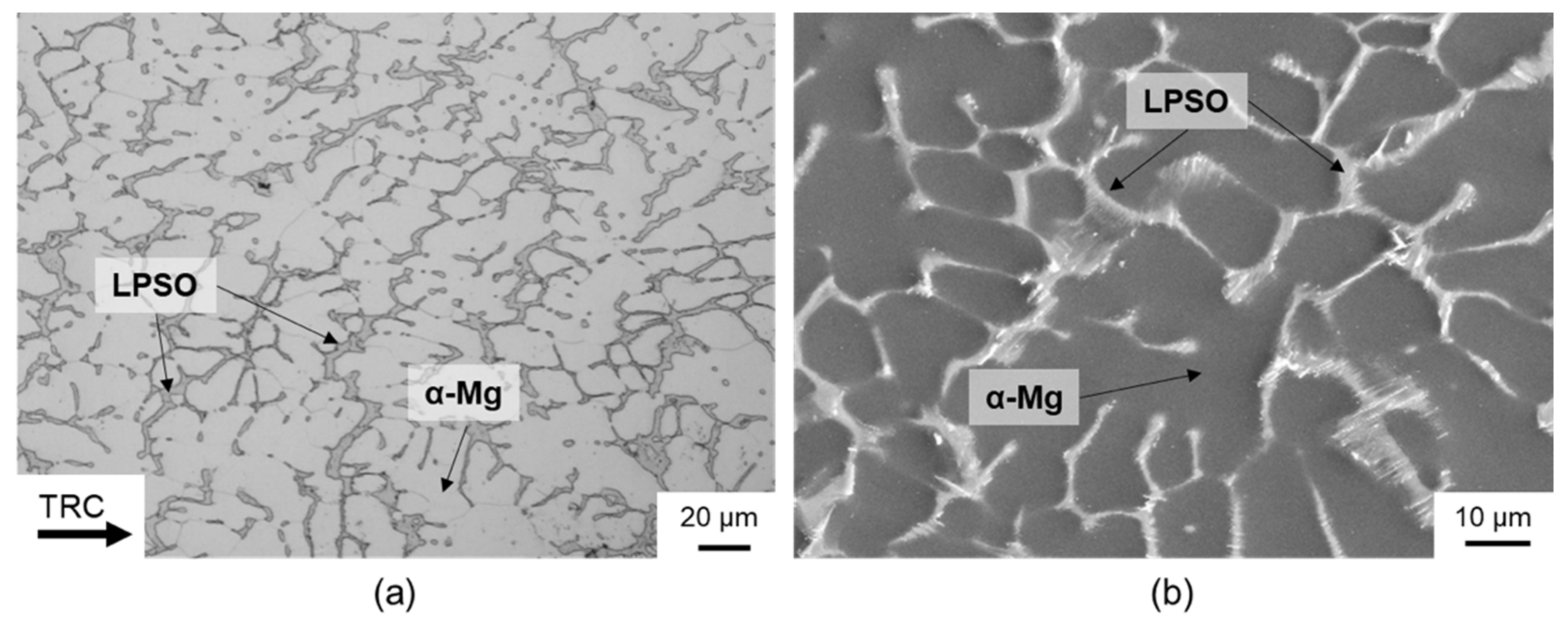
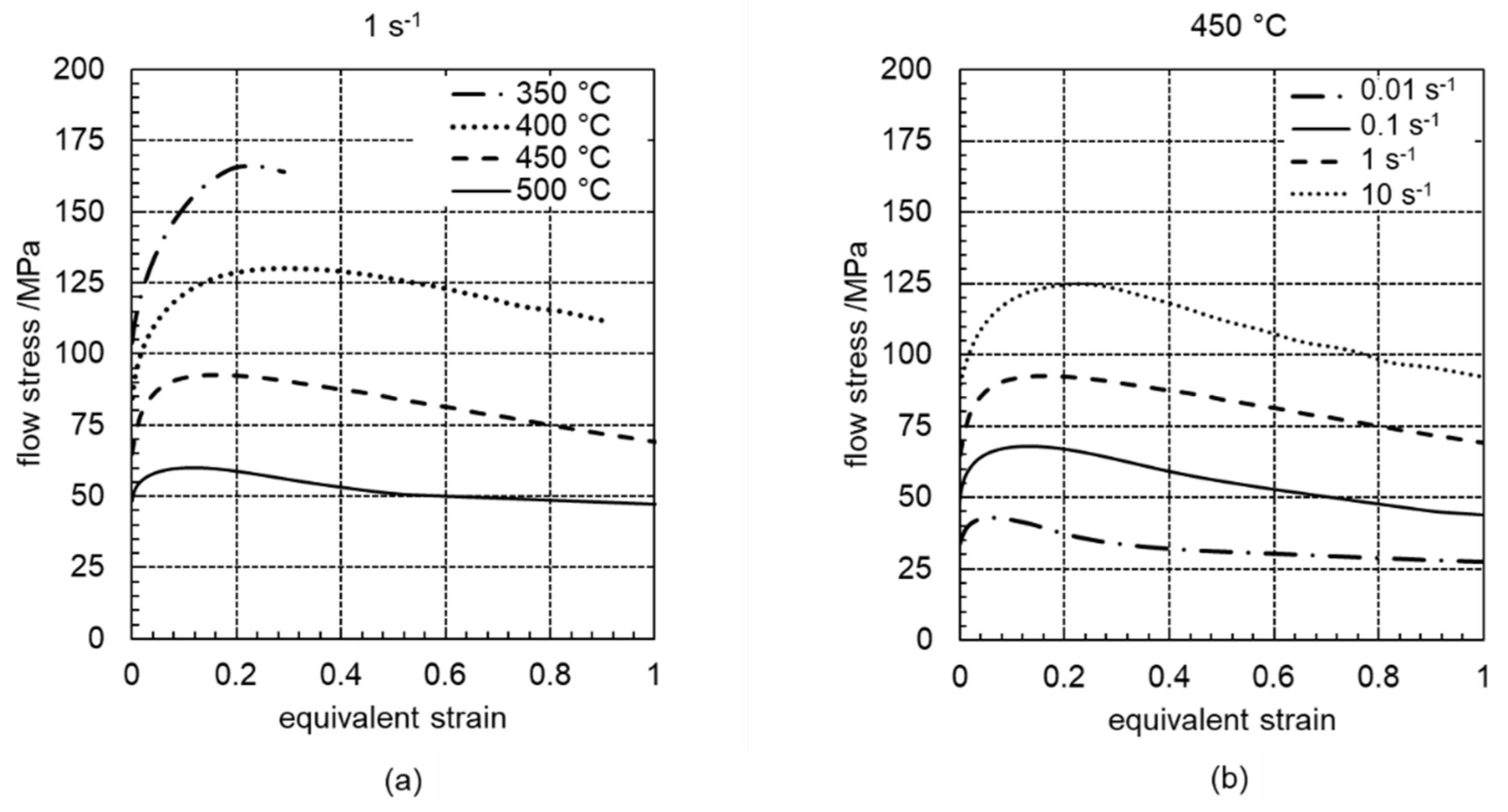
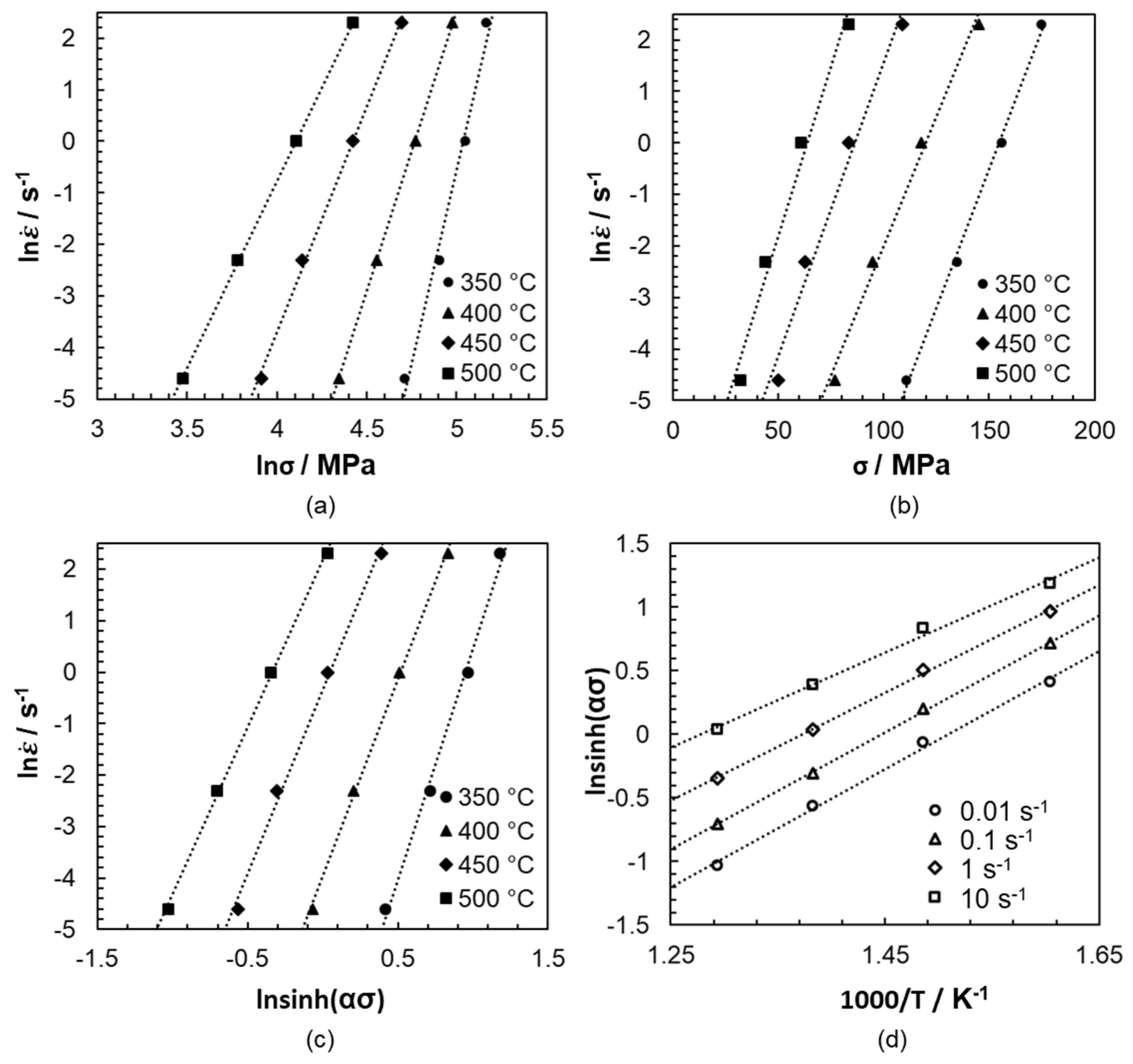
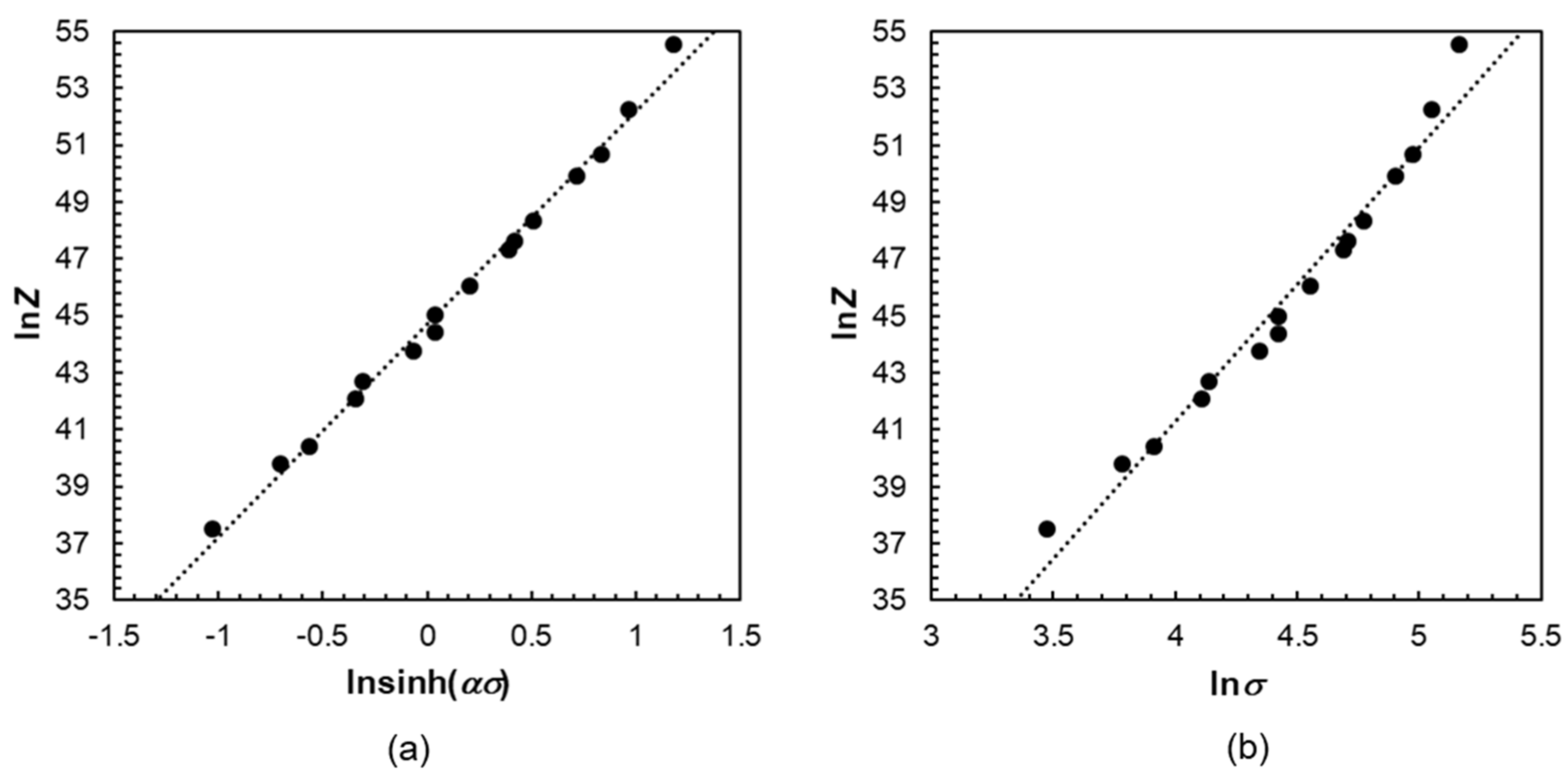
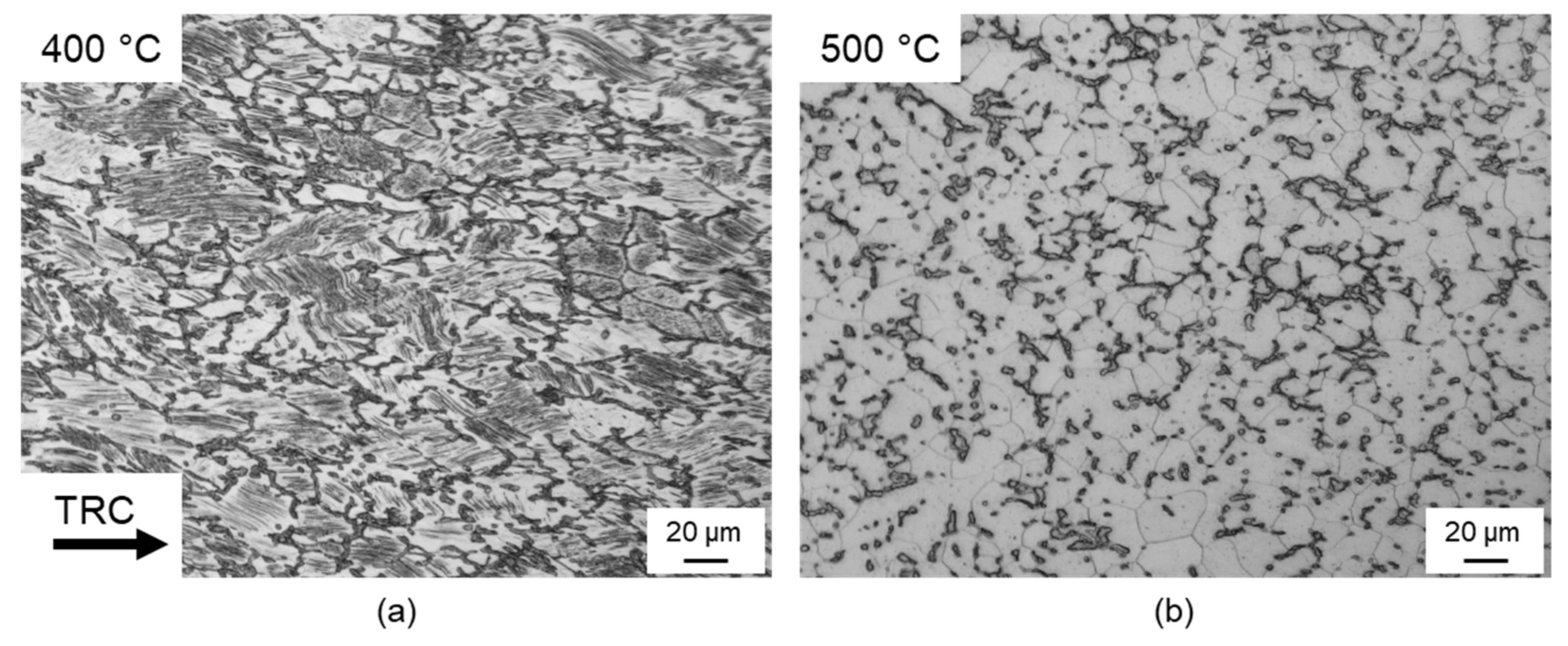

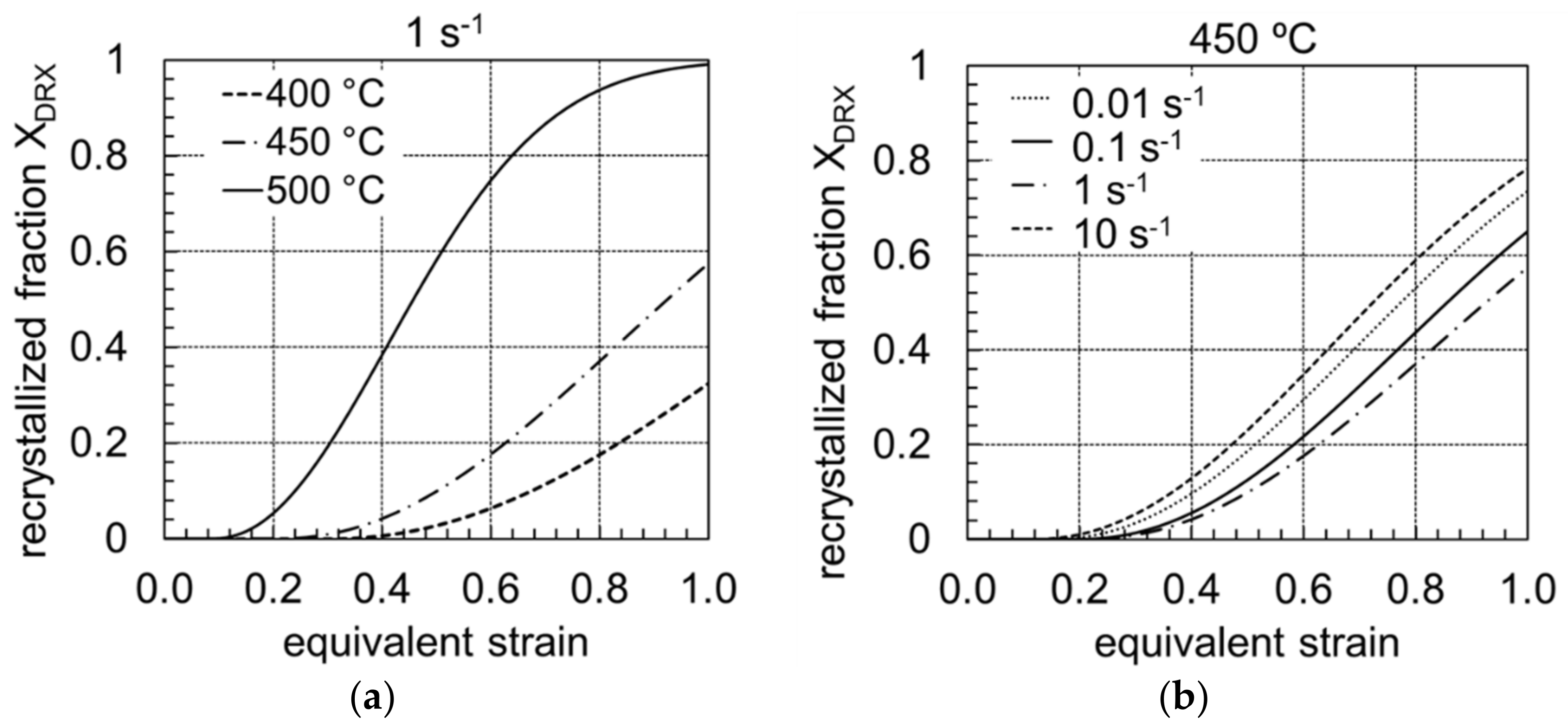

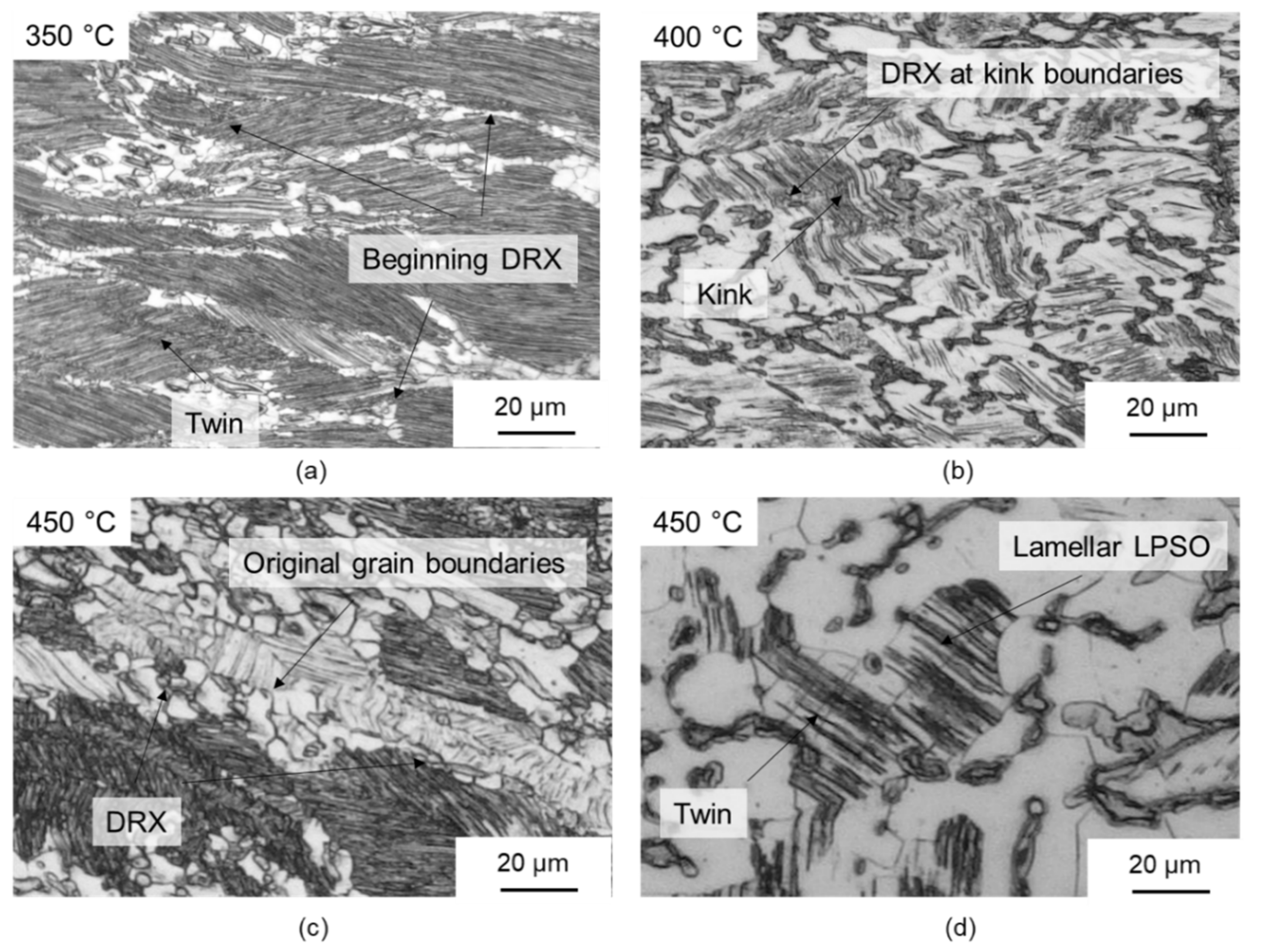

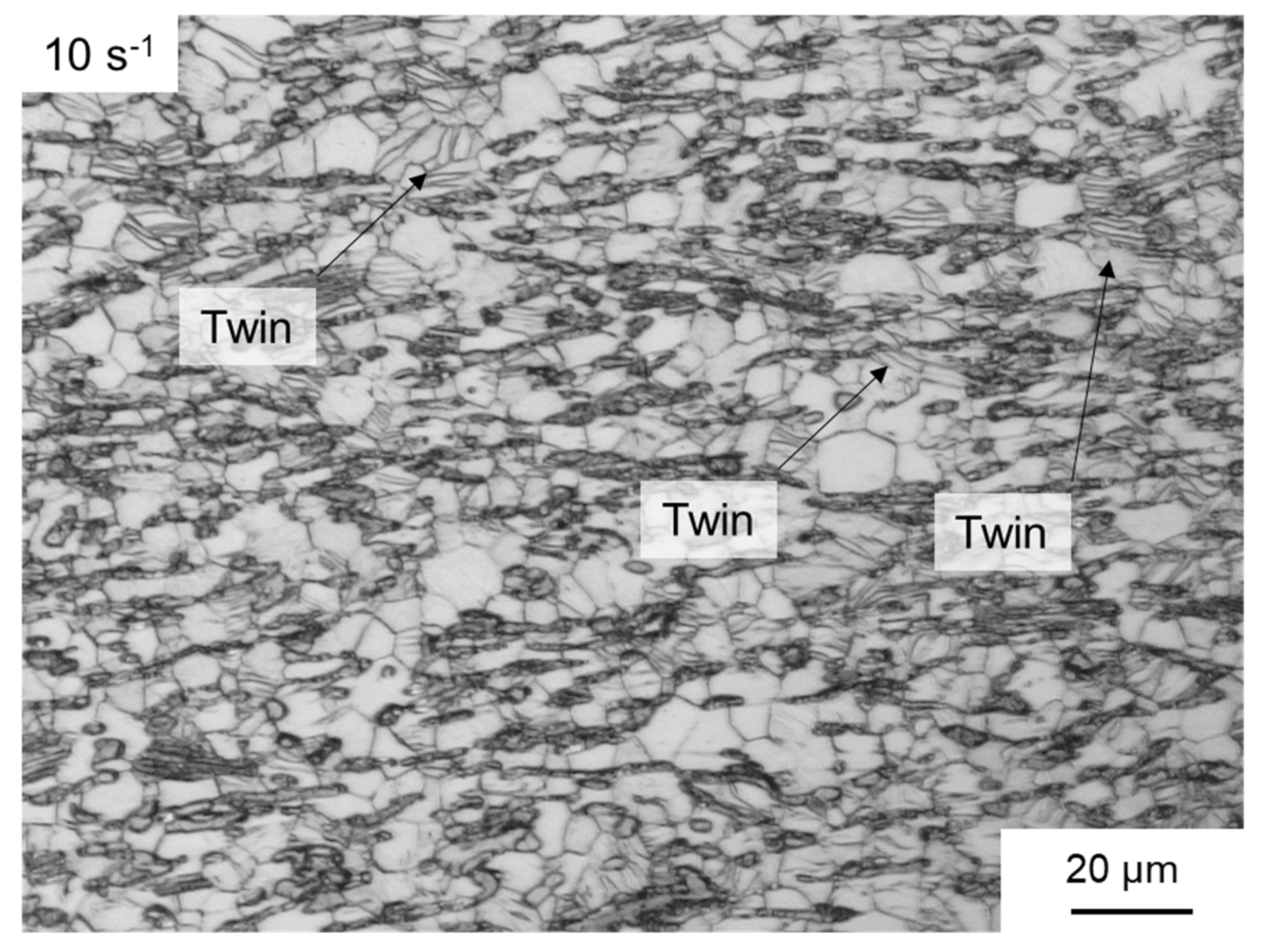
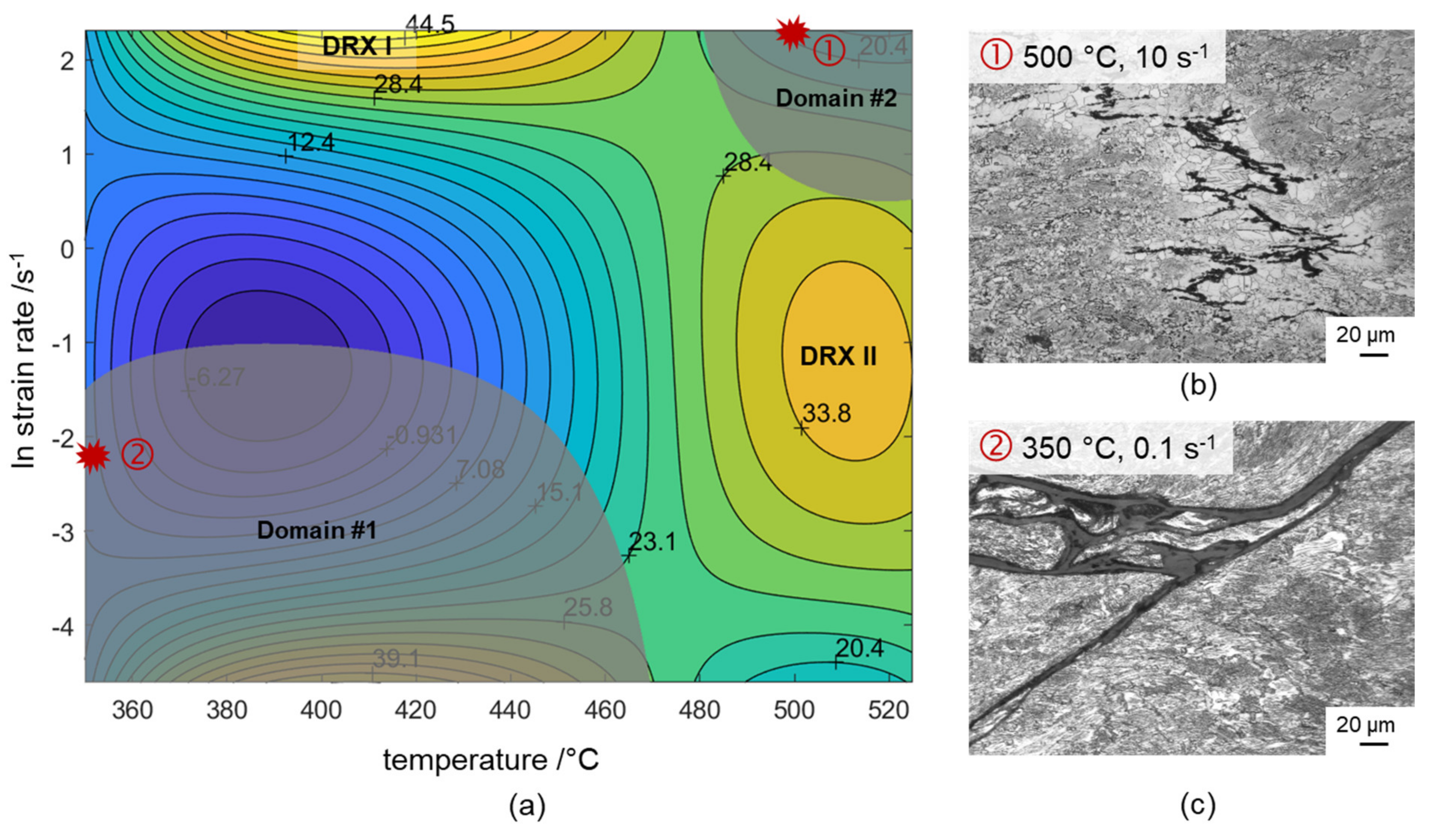
| Y | Zn | Zr | Si | Fe | Cu | Ni | Others | Mg |
|---|---|---|---|---|---|---|---|---|
| 6.8 | 2.5 | 0.4 | 0.01 | 0.005 | 0.001 | 0.001 | 0.01 | Balance |
Publisher’s Note: MDPI stays neutral with regard to jurisdictional claims in published maps and institutional affiliations. |
© 2021 by the authors. Licensee MDPI, Basel, Switzerland. This article is an open access article distributed under the terms and conditions of the Creative Commons Attribution (CC BY) license (http://creativecommons.org/licenses/by/4.0/).
Share and Cite
Ullmann, M.; Kittner, K.; Prahl, U. Hot Deformation and Dynamic Recrystallisation Behaviour of Twin-Roll Cast Mg-6.8Y-2.5Zn-0.4Zr Magnesium Alloy. Materials 2021, 14, 307. https://doi.org/10.3390/ma14020307
Ullmann M, Kittner K, Prahl U. Hot Deformation and Dynamic Recrystallisation Behaviour of Twin-Roll Cast Mg-6.8Y-2.5Zn-0.4Zr Magnesium Alloy. Materials. 2021; 14(2):307. https://doi.org/10.3390/ma14020307
Chicago/Turabian StyleUllmann, Madlen, Kristina Kittner, and Ulrich Prahl. 2021. "Hot Deformation and Dynamic Recrystallisation Behaviour of Twin-Roll Cast Mg-6.8Y-2.5Zn-0.4Zr Magnesium Alloy" Materials 14, no. 2: 307. https://doi.org/10.3390/ma14020307
APA StyleUllmann, M., Kittner, K., & Prahl, U. (2021). Hot Deformation and Dynamic Recrystallisation Behaviour of Twin-Roll Cast Mg-6.8Y-2.5Zn-0.4Zr Magnesium Alloy. Materials, 14(2), 307. https://doi.org/10.3390/ma14020307







